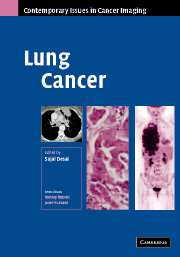Book contents
- Frontmatter
- Contents
- Contributors
- Series Foreword
- Introduction
- 1 Clinical Considerations in Lung Cancer
- 2 Pathology of Lung Cancer
- 3 Imaging of Lung Cancer
- 4 Screening for Lung Cancer
- 5 Staging of Lung Cancer
- 6 Positron Emmision Tomography in Lung Cancer
- 7 Contemporary Issues in the Systemic Treatment of Lung Cancer
- 8 Radiotherapy in Lung Cancer
- 9 Surgery for Lung Cancer
- Index
- Plate Section
- References
8 - Radiotherapy in Lung Cancer
Published online by Cambridge University Press: 12 August 2009
- Frontmatter
- Contents
- Contributors
- Series Foreword
- Introduction
- 1 Clinical Considerations in Lung Cancer
- 2 Pathology of Lung Cancer
- 3 Imaging of Lung Cancer
- 4 Screening for Lung Cancer
- 5 Staging of Lung Cancer
- 6 Positron Emmision Tomography in Lung Cancer
- 7 Contemporary Issues in the Systemic Treatment of Lung Cancer
- 8 Radiotherapy in Lung Cancer
- 9 Surgery for Lung Cancer
- Index
- Plate Section
- References
Summary
Introduction
Lung cancer is the second most common malignancy diagnosed in men after prostate cancer and third most common after breast and colorectal in women. In 2000, there were 38,410 new cases of lung cancer diagnosed in the UK. Incidence increases with age, with the most prevalent age group being the over 75s. As indicated in the chapter on chemotherapy for non-small cell lung cancer (NSCLC), survival rates remain low for patients treated with chemotherapy alone. Radiotherapy is an alternative modality of treatment which offers improved survival advantage to those with locally advanced disease.
Small cell lung cancer is a chemosensitive tumour. Nevertheless, studies have shown that radiotherapy can improve local control in patients who achieve a complete response following chemotherapy and who have disease localized to the chest. There are also data that suggest that some of these patients benefit from prophylactic cranial irradiation, in the absence of proven brain metastases.
A further important role for radiotherapy in lung cancer patients is to treat symptomatic metastatic disease. This is usually in the palliative setting and the location of the metastatic deposit has a bearing on whether radiotherapy is suitable or not. However, radiation therapy can be an extremely effective treatment for symptoms such as pain, haemoptysis and cough. There are certain situations where emergency or urgent radiotherapy is the treatment of choice (e.g. spinal cord compression). Patients are treated in a multidisciplinary setting to ensure optimum management of each individual case.
- Type
- Chapter
- Information
- Lung Cancer , pp. 120 - 135Publisher: Cambridge University PressPrint publication year: 2006



